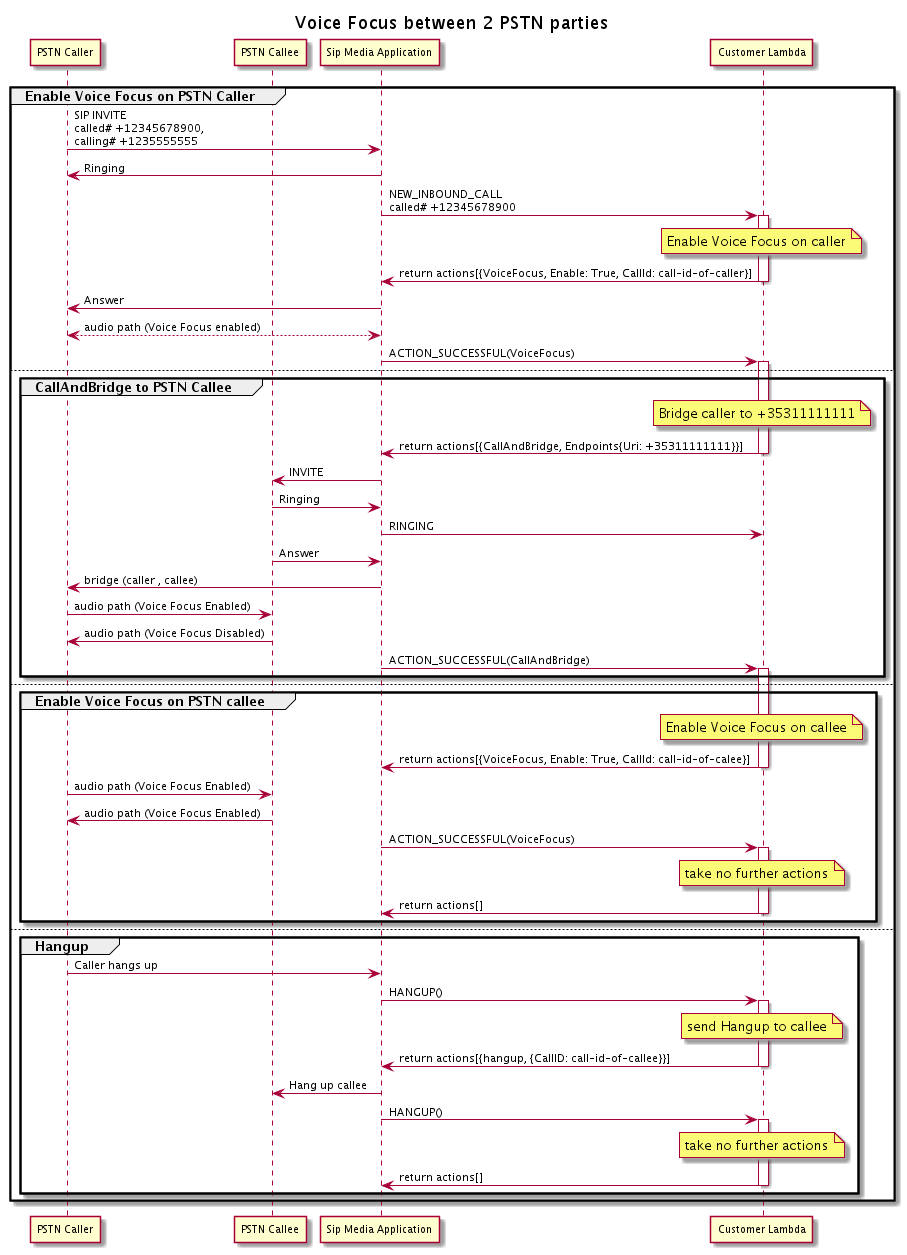Understanding VoiceFocus for the Amazon Chime SDK PTSN audio service
Enables you to apply Amazon Voice Focus noise suppression to inbound and outbound call legs on a public switched telephony network (PSTN) call. When you apply Amazon Voice Focus, it reduces background noise without impacting human speech. This can make the current speaker easier to hear.
To create inbound call legs, you use a SIP rule that invokes an
AWS Lambda function with a NewInboundCall event. You can create outbound call legs
by using the CallAndBridge action, or by
using a CreateSIPMediaApplicationCall API operation. For more
information about Amazon Voice Focus, see How the Amazon Chime SDK's noise cancellation works
Amazon Voice Focus reduces unwanted, non-speech noises, including:
-
Environment noises—wind, fans, running water
-
Background noises—lawnmowers, barking dogs
-
Foreground noises—typing, paper shuffling
Note
When you use Amazon Voice Focus, AWS bills you for the active call minutes of each call leg and for each minute of SIP media application usage.
This example shows a typical VoiceFocus action.
{ "SchemaVersion": "1.0", "Actions":[ { "Type": "VoiceFocus", "Parameters": { "Enable":True|False, // required "CallId": "call-id-1", // required } } ] }
- Enable
-
Description – Enables or disables Amazon Voice Focus
Allowed values –
True|FalseRequired – Yes
Default value – None
- CallId
-
Description – CallId of participant in the
CallDetailsof the AWS Lambda function invocationAllowed values – A valid call ID
Required – Yes
Default value – None
This example shows a successful ACTION_SUCCESSFUL event for the
VoiceFocus action.
{ "SchemaVersion": "1.0", "Sequence": 3, "InvocationEventType": "ACTION_SUCCESSFUL", "ActionData": { "Type": "VoiceFocus", "Parameters": { "Enable":True, "CallId": "call-id-1" } }, "CallDetails":{ ..... ..... "Participants":[ { "CallId": "call-id-of-caller", ..... "Status": "Connected" }, { "CallId": "call-id-of-callee", ..... "Status": "Connected" } ] } }
This example shows a typical ACTION_FAILED event for the
VoiceFocus action.
{ "SchemaVersion": "1.0", "Sequence":2, "InvocationEventType": "ACTION_FAILED", "ActionData":{ "Type": "VoiceFocus", "Parameters": { "Enable":True, "CallId": "call-id-1" } }, "ErrorType": "SystemException", "ErrorMessage": "System error while running action" }, "CallDetails":{ ..... ..... "Participants":[ { "CallId": "call-id-of-caller", ..... } ] } }
Error handling
For security reasons, the PSTN audio actions have a limit of 5 call requests per second,
per customer account (CPS). When call requests exceed the 5 CPS limit, the action returns
an error message. This table lists the error messages returned by the
VoiceFocus action.
| Error | Message | Reason |
|---|---|---|
|
Failed to run action. The maximum number of actions per second has been reached. | The number of Voice Focus action requests per second exceeded the system limit. |
|
Missing required action parameter. |
Missing one or more of the required parameters while running the action. |
|
System error while running action. |
A system error occurred while running the action. |
Call flows
This diagram shows the call flow for enabling and disabling Amazon Voice Focus for a
CallAndBridge action between two PSTN calls.

For the outbound call leg, the AWS Lambda function enables Amazon Voice focus for the caller
and returns a set of actions, including CallAndBridge. Once the call is bridged,
the VoiceFocus action returns an ACTION_SUCCESSFUL event, and the
Lambda function returns another set of events that enables Amazon Voice Focus for the person
being called. That set of actions includes VoiceFocus, Enable,
True, and the caller's ID. No further action is taken until the caller hangs
up. The Lambda function then sends a Hangup action to the SIP media application.
The application hangs up the person being called and sends a Hangup function back to the
Lambda function, which takes no further actions.